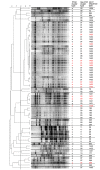Novel Sequence Type in Bacillus cereus Strains Associated with Nosocomial Infections and Bacteremia, Japan
- PMID: 31002057
- PMCID: PMC6478208
- DOI: 10.3201/eid2505.171890
Novel Sequence Type in Bacillus cereus Strains Associated with Nosocomial Infections and Bacteremia, Japan
Abstract
Bacillus cereus is associated with foodborne illnesses characterized by vomiting and diarrhea. Although some B. cereus strains that cause severe extraintestinal infections and nosocomial infections are recognized as serious public health threats in healthcare settings, the genetic backgrounds of B. cereus strains causing such infections remain unknown. By conducting pulsed-field gel electrophoresis and multilocus sequence typing, we found that a novel sequence type (ST), newly registered as ST1420, was the dominant ST isolated from the cases of nosocomial infections that occurred in 3 locations in Japan in 2006, 2013, and 2016. Phylogenetic analysis showed that ST1420 strains belonged to the Cereus III lineage, which is much closer to the Anthracis lineage than to other Cereus lineages. Our results suggest that ST1420 is a prevalent ST in B. cereus strains that have caused recent nosocomial infections in Japan.
Keywords: Bacillus cereus; Japan; bacteremia; bacteria; enteric infections; food safety; multilocus sequence typing; nosocomial infections; phylogenetic analysis; pulsed-field gel electrophoresis; repetitive-element PCR.
Figures



Similar articles
-
Bacillus cereus nosocomial infection from reused towels in Japan.J Hosp Infect. 2008 Aug;69(4):361-7. doi: 10.1016/j.jhin.2008.04.014. Epub 2008 Jul 7. J Hosp Infect. 2008. PMID: 18602188
-
DnaJ sequences of Bacillus cereus strains isolated from outbreaks of hospital infection are highly similar to Bacillus anthracis.Diagn Microbiol Infect Dis. 2011 Jul;70(3):307-15. doi: 10.1016/j.diagmicrobio.2011.02.012. Diagn Microbiol Infect Dis. 2011. PMID: 21683265
-
Nosocomial bacteremia caused by biofilm-forming Bacillus cereus and Bacillus thuringiensis.Intern Med. 2009;48(10):791-6. doi: 10.2169/internalmedicine.48.1885. Epub 2009 May 15. Intern Med. 2009. PMID: 19443973
-
Bacillus cereus Invasive Infections in Preterm Neonates: an Up-to-Date Review of the Literature.Clin Microbiol Rev. 2022 Apr 20;35(2):e0008821. doi: 10.1128/cmr.00088-21. Epub 2022 Feb 9. Clin Microbiol Rev. 2022. PMID: 35138121 Free PMC article. Review.
-
The Bacillus cereus group: novel aspects of population structure and genome dynamics.J Appl Microbiol. 2006 Sep;101(3):579-93. doi: 10.1111/j.1365-2672.2006.03087.x. J Appl Microbiol. 2006. PMID: 16907808 Review.
Cited by
-
Cultivated meat microbiological safety considerations and practices.Compr Rev Food Sci Food Saf. 2025 Jan;24(1):e70077. doi: 10.1111/1541-4337.70077. Compr Rev Food Sci Food Saf. 2025. PMID: 39731713 Free PMC article. Review.
-
Biosynthesis Optimization of Antibacterial-Magnetic Iron Oxide Nanoparticles from Bacillus megaterium.Biol Trace Elem Res. 2025 Jan;203(1):467-484. doi: 10.1007/s12011-024-04168-7. Epub 2024 Apr 12. Biol Trace Elem Res. 2025. PMID: 38607527
-
Genomic analysis and potential polyhydroxybutyrate (PHB) production from Bacillus strains isolated from extreme environments in Mexico.BMC Microbiol. 2025 Jan 11;25(1):15. doi: 10.1186/s12866-024-03713-7. BMC Microbiol. 2025. PMID: 39799315 Free PMC article.
-
Genetic diversity and virulence of Bacillus cereus group isolates from bloodstream infections.Microbiol Spectr. 2025 Mar 4;13(3):e0240724. doi: 10.1128/spectrum.02407-24. Epub 2025 Jan 28. Microbiol Spectr. 2025. PMID: 39873504 Free PMC article.
-
Phylogenetic Analysis of Bacillus cereus sensu lato Isolates from Commercial Bee Pollen Using tRNACys-PCR.Microorganisms. 2020 Apr 6;8(4):524. doi: 10.3390/microorganisms8040524. Microorganisms. 2020. PMID: 32268545 Free PMC article.
References
Publication types
MeSH terms
Substances
LinkOut - more resources
Full Text Sources
Other Literature Sources

